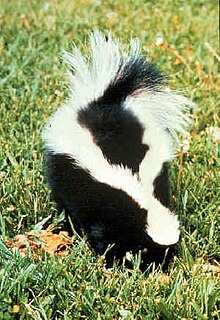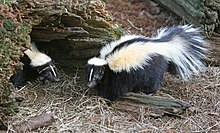Skunk - Simple English Wikipedia, the free encyclopedia

| Skunks | |
|---|---|
 | |
| Striped skunks | |
| Scientific classification | |
| Domain: | Eukaryota |
| Kingdom: | Animalia |
| Phylum: | Chordata |
| Class: | Mammalia |
| Order: | Carnivora |
| Superfamily: | Musteloidea |
| Family: | Mephitidae |
| Groups included | |
 | |
| Skunk genera ranges | |
| Cladistically included but traditionally excluded taxa | |
A skunk is a mammal, usually black with a white stripe on its back and a fluffy tail, but some skunks can be brown or gray. Its most special part is that it can shoot out a bad-smelling spray from under its tail; it does this to scare away things that could hurt it. Some people keep skunks as pets.
It can eat both plants and small animals like earthworms, frogs, snakes, birds and eggs. It usually eats berries, leaves, grasses and nuts. In places where humans live, skunks often steal food from garbage or pet bowls.
The striped skunk is the most well-known kind of skunk. It weighs 2.5 to 14 pounds (1.2–6.3 kg) with a body length (without the tail) of 13 to 18 inches (33–46 cm). The tail is 7 to 10 inches long (18–25 cm), and sometimes has a white tip.
Most types of skunk live in the United States and Canada, but there are also types that live in Indonesia and the Philippines.
There are ten living species of skunks in four genera: Conepatus (hog-nosed skunks, four species); Mephitis (the hooded and striped skunks, two species) and Spilogale (spotted skunks, four species). All wild skunks inhabit the Americas, ranging from Canada to central South America.


 French
French Deutsch
Deutsch